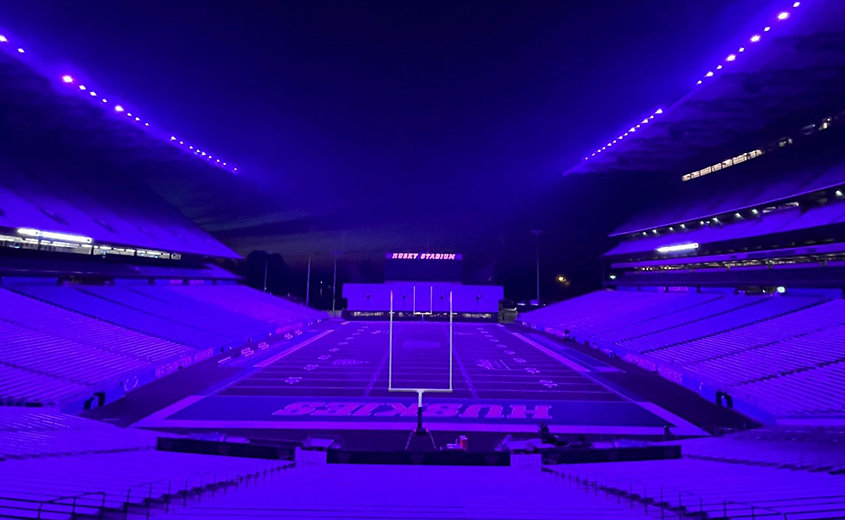Dazzling display for Husky fans

Husky Stadium turns purple, thanks to LED lights installed this summer. UW Athletics
Every September, UW sports fans return to campus decked out in Husky colors — but this year, they won’t be the only ones creating a purple haze on Montlake. The venues can turn purple too, thanks to new sports lighting.
This summer, LED lights were installed in both Husky Stadium and Alaska Airlines Arena at Hec Edmundson Pavilion. The new lights are a plus for the UW and the fans. They not only save energy but can also turn colors, sync with music, turn on and off in wave sequences, and more.
UW Athletics had been exploring upgrading for some time, but the decision to move forward goes back to a UW Football game on Nov. 5 last year. A power surge caused an outage, and because the lighting required time to power back up, the game was delayed for 25 minutes.
LEDs have instant on and off capabilities, so the incident showed it was the right time to make the change, said Chip Lydum, associate athletic director for Operations & Capital Projects.
“[If there’s an outage] those lights will come right back. We'll have the full capability right away,” he said. “It’s very much a win-win that we can achieve a fun game-day experience and then give ourselves a little security for playability.”
Energy savings
UW Athletics believes the new lights will reduce energy consumption by 41% in Husky Stadium and 68% in Alaska Airlines Arena, Lydum said. Along with the energy savings from the efficient LED technology, technicians will also be able to more precisely control the level of lighting, making them dimmer or brighter as needed.
The savings in reduced energy bills, together with rebates from the city of Seattle, means the $3.6 million project will eventually provide net savings for UW Athletics. It’s also a reflection of UW’s commitment to sustainability.
“Reduced energy cost was a really important driver of this project,” said project manager Yannick Mathews, who is part of UW Facilities’ Project Delivery Group. “We made it a focal point to have the energy-use conversation wherever we could and really take advantage of all opportunities to go in on the energy-savings aspect of it all.”
Taking it to the skies
Because the venues host high-profile and iconic events on campus — not only athletics but also graduation, new student convocation and more — the project had an aggressive timeline between June and September.
In the team’s search for electrical contracting companies, it found that many wanted to take on the more straightforward project of Alaska Airlines Arena but fewer put in bids for Husky Stadium.
With more time for the project, a company could build a crane to install the lights in one area and then move it to cover the full space. But that wouldn’t work with the tight schedule. So the UW and its partners got creative. Prime Electric, the contractor chosen for Husky Stadium, said they could use helicopters to remove the old lights and install new ones, and they could do it in one day.
With a contractor on board, the UW had to pull it off on their end. A helicopter lift had been similarly used at the University only once before — for a project at UW Medical Center. With the advice of that team and the expertise of Prime Electric, Mathews was able to put a plan in place. He got sign off from the Federal Aviation Administration, local police, the fire department and campus partners.
Everything came together in just two weeks. On July 13, helicopters made 88 trips from the ground to the roof of Husky Stadium.
Watching (and filming) the installation, Lydum felt some apprehension.
“Flying helicopters has some risks, and it causes anxiety,” he said. “But a lot of prep went into it, and this is an example of an amazing vision and a lot of people coming together with a lot of optimism and can-do attitude.”
In the end, the project was completed in time for the start of UW Athletics in the fall. Husky Stadium’s LED lights were installed by July 30, well ahead of the beginning of the UW Football season. Alaska Airlines Arena’s were in place by Aug. 29, in time for the first home UW Volleyball game on Sept. 7.
Lydum said it was their turn to rise to the occasion, just like the athletes do.
“We ask our students and our coaches to perform at a high level with a small margin for error. We ask them to be great with a lot of risk,” he said. “It was our moment to step up and do it, and I felt like everybody had that mindset.”
It also connected them with the larger mission of the UW, said Mathews.
“That's always something that you strive for, to do good work, but in the most sustainable ways you can,” he said. “When there are opportunities to really reduce usage and help out — even in what might seem like a small way but, it turns out, is not so small — that’s also really gratifying. It’s what keeps us coming back.”



